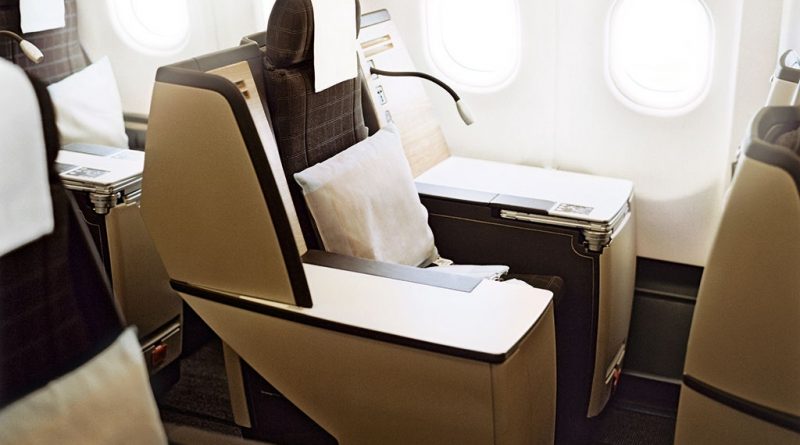The Best Ways to Spend Your Chase Sapphire Preferred Welcome Bonus
Condé Nast Traveler has partnered with CardRatings for our coverage of credit card products. Condé Nast Traveler and CardRatings may receive a commission from card issuers. We don’t review or include all companies, or all available products. Moreover, the editorial content on this page was not provided by any of the companies mentioned, and has not been reviewed, approved or otherwise endorsed by any of these entities. Opinions expressed here are entirely those of Condé Nast Traveler’s editorial team.
The Chase Sapphire Preferred has been one of the most popular rewards credit cards available for almost a decade, thanks to benefits like bonus points on travel and dining purchases and the ability to transfer points to more than a dozen airline and hotel partners.
As travel starts its road to recovery in 2021, now is a great time to work on earning welcome bonuses to cash in down the line: The Chase Sapphire Preferred is currently offering a welcome bonus of 60,000 points after you spend $4,000 in the first three months.
That sounds like a lot of points, but what does it actually get you? We’re going to look at a few different ways you can redeem 60,000 Chase Ultimate Rewards points for travel so you reap the most value from them.
In case you are looking to stock up on Ultimate Rewards points with different cards, the Chase Sapphire Reserve is offering 50,000 bonus points after you make $4,000 in purchases in the first three months. In addition to a higher annual fee of $550, it also offers premium perks like airport lounge access, $300 in annual travel statement credits, up to $120 off DoorDash orders in 2021, and a Global Entry or TSA Precheck application fee statement credit every four years.
Learn more about applying for the Chase Sapphire Reserve here.
Chase also offers a credit card for small businesses that earns Ultimate Rewards points called the Ink Business Preferred. Its sign-up bonus is currently 100,000 bonus points after spending $15,000 in the first three months. The Ink Business Preferred earns three points per dollar on up to $150,000 spent each year on travel, shipping, cable, phone, internet, and advertising purchases. Its annual fee is $95, which is the same as the Chase Sapphire Preferred.
Learn more about applying for the Chase Ink Business Preferred here.
Below, everything to get you started on redeeming your Chase Sapphire Preferred welcome bonus.
What are Ultimate Rewards points?
First, a quick primer on Ultimate Rewards points, and how you can use them. Depending on the Chase card you carry, you can either redeem your Ultimate Rewards points as cash back for purchases, including travel bookings, or you can transfer them to 13 partner programs. They include:
Airline Partner Programs
· Aer Lingus AerClub
· Air France/KLM Flying Blue
· British Airways Executive Club
· Emirates Skywards
· Iberia Plus
· JetBlue TrueBlue
· Singapore Airlines KrisFlyer
· Southwest Rapid Rewards
· United MileagePlus
· Virgin Atlantic
Hotel Partner Programs
· World of Hyatt
· IHG Rewards Club
· Marriott Bonvoy
Ultimate Rewards points convert to the points or miles of all these programs at a ratio of 1:1, and for the most part, transfers take place instantly. You just have to link your Ultimate Rewards account to your individual frequent flier and hotel points profiles and you can transfer at will.
The other main way to redeem Ultimate Rewards points for travel is to log into the Chase travel portal, which is powered by Expedia. If you have the Chase Sapphire Preferred or Ink Business Preferred, your points are worth 1.25 cents apiece toward flights, hotel reservations, car rentals, tours and cruises. Those with the Chase Sapphire Reserve get 1.5 cents per point in value.
Best ways to redeem 60,000 Ultimate Rewards points
With that in mind, here are a few redemption opportunities that represent a great use of Ultimate Rewards points.
The key to getting the most value from your Ultimate Rewards points is to think creatively about the program’s transfer partners (and the partners of those partners, like airline alliance members). You should also take a close look at the actual dollar or cent value you get from each point you redeem, based on some simple math. Here are five concrete suggestions for when it’s safe to travel again.
1. Take a romantic trip to Hawaii
One of the most versatile transfer partners of Ultimate Rewards is the British Airways Executive Club program because British Airways is partners with both American Airlines and Alaska Airlines. The program’s award mileage requirements are based on flight distances rather than charts with set values or dynamic pricing models where the more expensive the flight, the more miles you have to redeem for it. What all that means in practical terms is that if you want to fly from the West Coast to Hawaii, you will need far fewer British Airways Avios to fly either American Airlines or Alaska Airlines than using those carriers’ own miles.
For example, one round-trip economy award ticket from Los Angeles to Honolulu, Maui, or Kona on either American Airlines or Alaska costs just 26,000 British Airways Avios (and as a transfer partner, this will only require 26,000 Chase Ultimate Points—so the current welcome bonus will be enough to cover you and a significant other). By contrast, you typically need either 45,000 American Airlines miles or between 30,000 to 50,000 Alaska miles for the same itinerary. You are saving yourself around half the points or miles by using British Airways Avios instead of American or Alaska miles.
2. Book a stay with Hyatt
Compared to other hotel loyalty programs like Hilton Honors and Marriott Bonvoy, World of Hyatt has relatively low redemption rates for reward nights. The points required range between 3,500-45,000 per night. The 60,000-point sign-up bonus from the Chase Sapphire Preferred is usually enough for a two-night stay in Category 7 properties, which cost between 25,000-35,000 points per night depending on the property and the season.
This tier includes some of the chain’s most iconic luxury properties where room rates regularly top $800 per night, including the Park Hyatt Sydney with its spectacular Opera House views and the elegant Park Hyatt Paris-Vendôme.
3. Fly internationally using United miles
United has been overhauling its MileagePlus program lately and transitioning to a dynamic pricing model with award prices more closely matched to paid fares. That means a ticket that costs $50 might require 5,000 miles, but if it cost $250, you might have to redeem 25,000 miles for it. However, award prices on the airline’s numerous Star Alliance and other airline partners, including All Nippon Airways, Lufthansa, Singapore Airlines, and Swiss, tend to remain pretty stable.
You can usually reserve a round-trip economy ticket from the U.S. to Europe on United or its partners for 60,000 miles, or fly one-way in business class on United for 60,000 miles or on partners for 70,000 miles. If you stockpile a few more points, you can redeem 70,000 for a round-trip economy ticket to various Asian destinations including Tokyo and Shanghai, or a one-way business-class ticket for 80,000 miles.
We’ve seen some phenomenal economy fares as low as $300 round-trip to Europe and $400 to Asia in the past two years, so double check paid fares before booking your award. However, business-class tickets can top $6,000 each way from the U.S. to either Europe or Asia, and redeeming your miles that way might be a better option (and a more fun flight experience, too).
4. Don’t forget about JetBlue and Southwest
JetBlue and Southwest both have really robust route networks in the U.S. as well as flights to other destinations including Mexico, the Caribbean and Hawaii (for Southwest). What’s more, their mileage programs function more like cash-back rewards rather than traditional frequent flier miles. Basically, each Southwest or JetBlue point is worth a fixed value toward airfare. So if a seat is available on a flight and you have enough points to cover the cost, you can book it without having to worry about the availability of special award tickets opening up.
Southwest points are usually worth around 1.4 cents apiece while JetBlue points typically weigh in at around 1.1-1.3 cents in value, both of which might be worth it to save on some cheap economy fares. For example, you can fly Southwest from Baltimore-Washington International Airport to Nassau in the Bahamas for as low as $178 round-trip in the coming months. For the same tickets, you’d need to redeem just 9,360 Southwest Rapid Rewards points. You could take five of your closest friends along and still not burn through 60,000 Ultimate Rewards points.
Likewise, JetBlue has been offering some phenomenal fare deals as low as $59 each way between dozens of cities in the U.S. That’s about 4,900 points. Short, inexpensive flights on either JetBlue or Southwest can be a great way to save money by using your Ultimate Rewards points.
5. Redeem directly through the Chase travel portal for cheap flights and hotels
Finally, don’t forget about the option to redeem your points directly for bookings through the Chase travel portal. Since it is powered by Expedia, it pulls up all the same options you would see when booking through that site, and it’s easy to use. If you have the Chase Sapphire Preferred or Ink Business Preferred, your points are worth 1.25 cents apiece, while it goes up to 1.5 cents apiece with the Chase Sapphire Reserve. So 60,000 Ultimate Rewards points would be worth $750 to $900 in travel, depending on which card you have. In this case, you might want to do a little math and compare how many points you’d need for a specific redemption this way versus transferring to a partner program and redeeming for an award.
For example, a night at the relatively new St. Regis Hong Kong would cost you 70,000 Ultimate Rewards points transferred to Marriott Bonvoy. But based on room prices of $450 per night, you’d only need 30,000 to 36,000 Ultimate Rewards points if you redeemed directly through Chase, effectively saving half your points.
These are just a few ideas of how far 60,000 Chase Ultimate Rewards points can get you. Given how many different transfer partners and redemption offers there are, though, there are many other creative ways to redeem these flexible points. Remember to look at each transfer partner and which other airlines or hotel brands you can redeem with. Check the Chase portal for direct-redemption values, and do not worry too much about squeezing every last cent of value from your points. As long as you are able to use them to book the trips you want, you are succeeding.
Learn more about applying for the Chase Sapphire Preferred here.
Condé Nast Traveler has partnered with CardRatings for our coverage of credit card products. Condé Nast Traveler and CardRatings may receive a commission from card issuers.
More Inspiration from Condé Nast Traveler
Italian Gifts: What to Buy the Traveler Who Can’t Get Enough of Italy
20 Best Gifts for Travelers for $50 or Less
49 Movies That Will Transport You to New York City
Ambassadors Recommend the One Book to Read Before Visiting Their Country
The $20 Travel Accessory That Makes Sitting in Economy Bearable
23 Carry-On Essentials Our Editors Can’t Live Without
Source: Read Full Article




